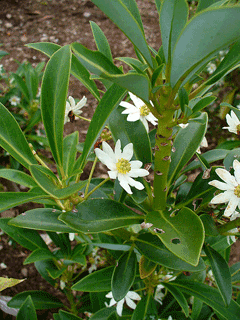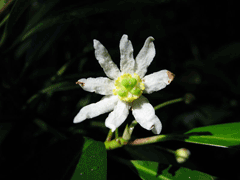 |
|
http://www.flickr.com/people/12017190@N06 |
 |
| http://commons.wikimedia.org/wiki/User:Butterfly_voyages |
Translate this page:
Summary
Physical Characteristics

 Drimys winteri is an evergreen Shrub growing to 7.5 m (24ft) by 6 m (19ft) at a medium rate.
Drimys winteri is an evergreen Shrub growing to 7.5 m (24ft) by 6 m (19ft) at a medium rate.
See above for USDA hardiness. It is hardy to UK zone 8. It is in leaf all year, in flower from January to June. The species is hermaphrodite (has both male and female organs).
Suitable for: light (sandy) and medium (loamy) soils and prefers well-drained soil. Suitable pH: mildly acid and neutral soils. It can grow in semi-shade (light woodland). It prefers moist soil. The plant can tolerates strong winds but not maritime exposure.
UK Hardiness Map
US Hardiness Map
Synonyms
D. aromatica. Murray. non (R.Br.)Muell. Wintera aromatica. Murray. non (R.Br.)Muell.
Plant Habitats
Woodland Garden Dappled Shade; Shady Edge;
Edible Uses
Edible Parts:
Edible Uses: Condiment
The aromatic pungent bark is powdered and used as a pepper substitute in Brazil, Chile and Argentina[2, 46, 69, 183]. It is rich in vitamin C[22].
References More on Edible Uses
Medicinal Uses
Plants For A Future can not take any responsibility for any adverse effects from the use of plants. Always seek advice from a professional before using a plant medicinally.
Antidandruff Antiscorbutic Aromatic Febrifuge Parasiticide Skin Stimulant Stomachic
Vitamin C
The bark is a pungent bitter tonic herb that relieves indigestion[238]. It is antiscorbutic, aromatic, febrifuge, skin, stimulant and stomachic. An infusion of the bark is used in the treatment of indigestion, colic, dandruff and scurvy[4, 46, 69, 139, 238]. It is also used as a parasiticide[4, 46, 69, 139]. The bark is harvested in the autumn and winter and is dried for later use[238].
References More on Medicinal Uses
The Bookshop: Edible Plant Books
Our Latest books on Perennial Plants For Food Forests and Permaculture Gardens in paperback or digital formats.

Edible Tropical Plants
Food Forest Plants for Hotter Conditions: 250+ Plants For Tropical Food Forests & Permaculture Gardens.
More

Edible Temperate Plants
Plants for Your Food Forest: 500 Plants for Temperate Food Forests & Permaculture Gardens.
More

More Books
PFAF have eight books available in paperback and digital formats. Browse the shop for more information.
Shop Now
Other Uses
Essential Parasiticide Wood
The powerfully aromatic bark contains resinous matter and 0.64% of aromatic essential oil[245]. Wood - not durable, heavy (it sinks in water) - interior of houses, boxes etc. It burns badly with a smell[46, 61, 69, 139].
Special Uses
Food Forest Scented Plants
References More on Other Uses
Cultivation details
Requires a light lime-free soil in semi-shade[202]. Tolerates chalk in the soil[11]. Requires a deep moist soil[11]. Dislikes dry conditions[139]. Prefers a warm sandy loam with some shelter[1]. Fairly wind resistant[49, 166]. Another report says that the plant resents severe wind-chill[202]. Succeeds against a wall at Kew[K] and it thrives in an open position in S.W. England[11, 49, 59]. Tolerates temperatures down to about -10°c[184]. This species is less hardy than D. lanceolata but it usually recovers from damage[120]. Another report says that it is hardier than D. lanceolata[200]. A very ornamental plant[11]. The sub-species D. winteri andina. Reiche. is a slow growing dwarf form seldom exceeding 1 metre in height[182]. It usually commences flowering when about 30cm tall[238]. A polymorphic species[139]. The flowers have a delicate fragrance of jasmine, whilst the bark has a powerful aromatic smell[245]. This plant was a symbol of peace to the indigenous Indian tribes of S. America in much the same way as an olive branch was used in Greece[139]. Plants in this genus are notably resistant to honey fungus[200].
References Carbon Farming Information and Carbon Sequestration Information
Temperature Converter
Type a value in the Celsius field to convert the value to Fahrenheit:
Fahrenheit:
The PFAF Bookshop
Plants For A Future have a number of books available in paperback and digital form. Book titles include Edible Plants, Edible Perennials, Edible Trees,Edible Shrubs, Woodland Gardening, and Temperate Food Forest Plants. Our new book is Food Forest Plants For Hotter Conditions (Tropical and Sub-Tropical).
Shop Now
Plant Propagation
Seed - best sown as soon as it is ripe in the autumn in a greenhouse[200]. Prick out the seedlings into individual pots when they are large enough to handle and grow on the plants for at least their first winter in a cold frame. Plant them out in late spring or early summer, after the last expected frosts. Layering in March/April. Takes 12 months[78]. Cuttings of half-ripe wood, 10 - 15 cm with a heel, July/August in a frame. Approximately 60% take[78]. Cuttings of mature wood of the current year's growth with a heel of older wood, November in a cold frame[78].
Other Names
If available other names are mentioned here
Chachaca, Palo de mambo,
Native Range
SOUTHERN AMERICA: Argentina, Chile,
Weed Potential
Right plant wrong place. We are currently updating this section.
Please note that a plant may be invasive in one area but may not in your area so it's worth checking.
Conservation Status
IUCN Red List of Threatened Plants Status :

Growth: S = slow M = medium F = fast. Soil: L = light (sandy) M = medium H = heavy (clay). pH: A = acid N = neutral B = basic (alkaline). Shade: F = full shade S = semi-shade N = no shade. Moisture: D = dry M = Moist We = wet Wa = water.
Now available:
Food Forest Plants for Mediterranean Conditions
350+ Perennial Plants For Mediterranean and Drier Food Forests and Permaculture Gardens.
[Paperback and eBook]
This is the third in Plants For A Future's series of plant guides for food forests tailored to
specific climate zones. Following volumes on temperate and tropical ecosystems, this book focuses
on species suited to Mediterranean conditions—regions with hot, dry summers and cool, wet winters,
often facing the added challenge of climate change.
Read More
Expert comment
Author
J.R.Forst.&G.Forst.
Botanical References
1169200
Links / References
For a list of references used on this page please go here
Readers comment